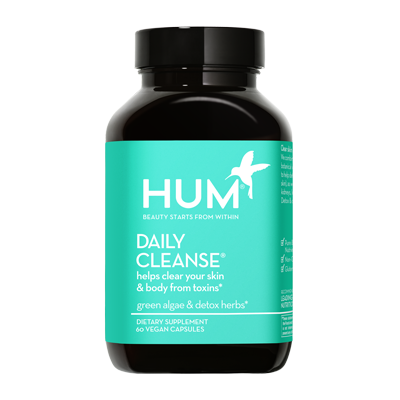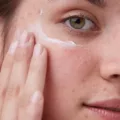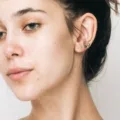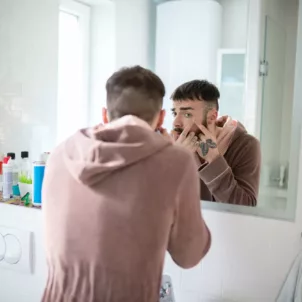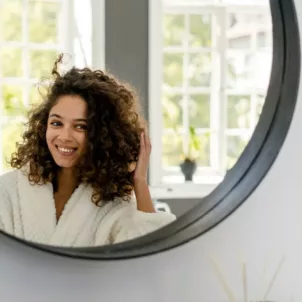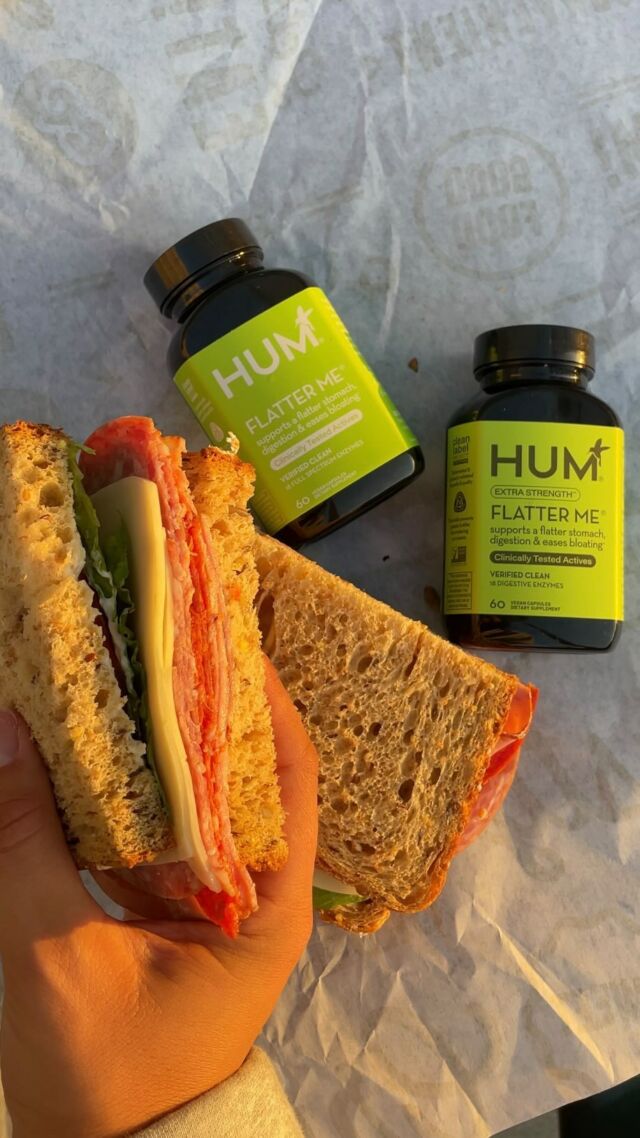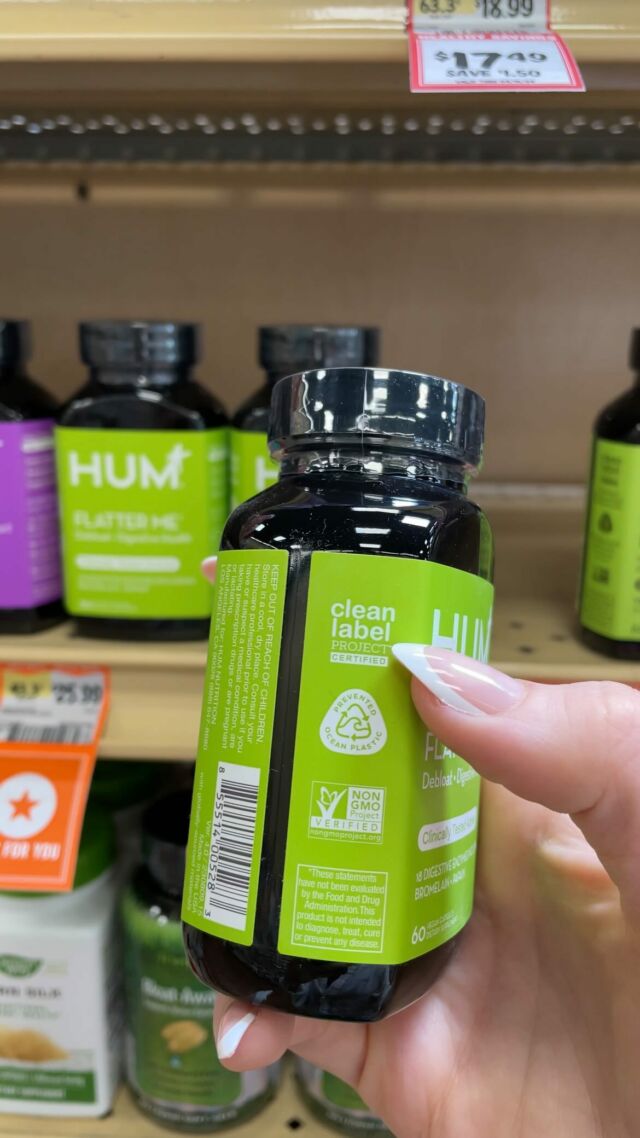At what age does acne go away? If you’re asking this question, chances are you’re suffering from adult acne and wondering how to deal with it. We spoke to experts to find out the truth about how long acne can last.
So your teen years are well behind you, but apparently, your skin didn’t get the memo. You know how to cleanse your skin, you do all the “right” things, and yet you’ve started breaking out again. Aren’t you too old for this? We’d like to say yes, but the fact of the matter is that adult acne happens—and it’s completely different from the breakouts of your teenage past.
While both men and women can suffer from adult acne, it’s much more prevalent in women. According to the Cleveland Clinic, around 50 percent of women in their 20s and 25 percent of women in their 40s will experience this skin concern—and, of course, many more adults will experience the occasional breakout. But that doesn’t mean you have to grin and bear it. There are adult acne treatments, but banishing blemishes for good depends on figuring out what’s causing the problem so you can take the appropriate action to combat it.
At What Age Does Acne Go Away?
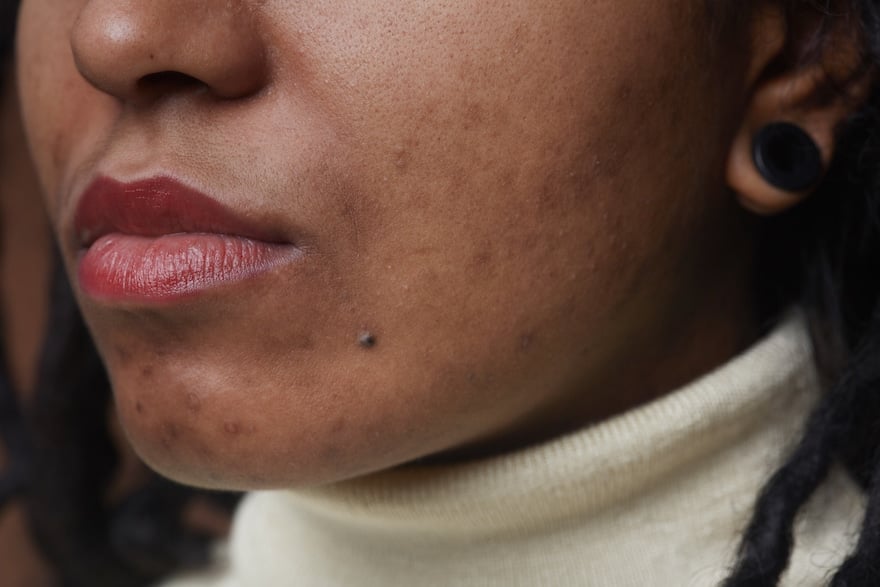
So, at what age does acne normally go away? The answer varies depending on what life stage you’re in. Teen acne, which starts around puberty, tends to resolve itself by the time you reach your early 20s. It’s caused by an excess of androgens, or male sex hormones, which subsequently increase oil production in your sebaceous glands. When your follicles get clogged and sebum is trapped, bacteria can flourish and cause pimples.
But what causes adult acne? “While teen acne is caused by increased oil production, adult acne is typically caused by hormonal changes and chronic stress,” says Michele Green, MD, a dermatologist at Lenox Hill Hospital in New York City. Still, androgens play a big role in adult acne, as does progesterone.
If you’re a woman, you’re more likely to deal with adult acne since women’s hormones can fluctuate for decades due to a variety of factors including menstrual cycles. You may be dealing with this problem for quite some time—until your hormones finally stabilize in menopause. The same is true for men, some of whom may experience andropause (aka male menopause) in their 50s, which leads to decreased levels of androgens, including testosterone, fewer hormonal shifts, and subsequent acne flare-ups.
For stress-related acne or acne related to some of the other causes we’ll cover below, no matter your age, your acne may not subside until you deal with the underlying cause.
How Is Adult Acne Different From Teen Acne?
Aside from the hormonal differences in teenage acne versus adult acne, it also typically appears in different spots. According to Dr. Green, acne during adolescence usually pops up in the T-zone, chest, and upper back, while adult acne caused by hormonal changes tends to appear around the chin and jawline. You might also find yourself dealing with adult cystic acne, a type of acne that forms deep underneath the surface of the skin, which can lead to pain, inflammation, and infection.
The other difference is that your skin, like many other things in your more mature body, doesn’t bounce back as quickly as it used to. “Because the skin’s cell turnover rate slows with age, adult skin takes a longer time to heal from breakouts, which may lead to acne scars that are hard to treat,” explains Dr. Green. “Adult skin is different from teen skin due to the decrease in collagen and elastin, longer cell-turnover rate, and [being] prone to sensitivity and dehydration. Therefore, treatment and skin-care ingredients for teenage acne may be too harsh for adults with acne.”
Adult Acne Causes
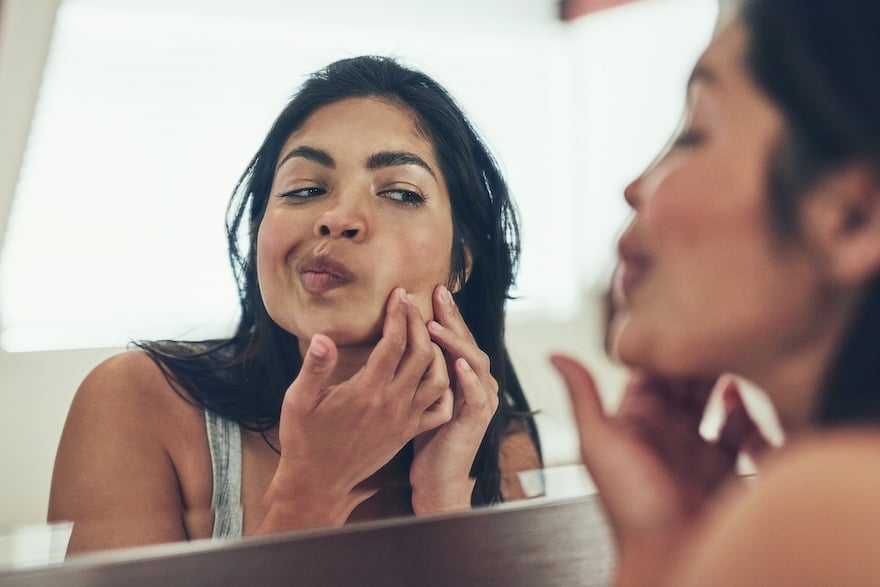
Before trying any treatments, you need to figure out exactly what’s causing your adult acne. The action you take should be tailored to your specific issue. The most important thing you need to know? Even though your skin seems like the problem, the actual problem often originates elsewhere in your body. “Our hormones are an orchestra of very fine-tuned biochemical molecules that interact with each other in various feedback mechanisms,” says holistic nutritionist Marius Morariu, cofounder of the Tracie Martyn spa and skin-care line. “Many things—including diet, stress, exercise, pregnancy, and supplements—affect this ecosystem one way or the other.”
While you can’t necessarily prevent all of your body’s hormonal fluctuations, you can be more aware of them and do your best to counter them. With that in mind, here are a few adult acne instigators:
Pregnancy
To create that little human growing inside of you, your body needs to brew a serious cocktail of hormones. “Higher progesterone and androgen levels lead to increased sebum production, which can clog pores,” says Dr. Green. “Those who have a history of acne are more likely to break out during pregnancy.” Thankfully, that acne will likely clear up almost immediately after you give birth. Some postpartum women, however, will have breakouts linger for weeks or months until their hormone levels return to normal.
Breastfeeding
While some women’s acne issues will resolve after childbirth, others will continue to experience issues while breastfeeding. The reason? Prolactin, which helps your body produce milk, can stimulate the sebaceous glands to produce more sebum, says Dr. Green. This, of course, increases your chance of breakouts, so be extra diligent about your skincare routine when breastfeeding, no matter how tired you are as a new mom.
Polycystic Ovary Syndrome (PCOS)
High levels of androgens play a major role in adult acne, and high androgen levels are a symptom of PCOS. (Other issues may include irregular menstrual cycles, unwanted body and facial hair, and an increased risk of diabetes and high blood pressure.) If you are suffering from PCOS, your acne may appear on your jawline, chin, and upper neck, according to Harvard Health Publishing. Birth control pills, oral medication, and a tailored PCOS treatment plan can help get this issue under control.
An Inflammatory Diet
Certain foods cause inflammation in your body, and that can wreak havoc on everything from your heart to your joints to your gut to—you guessed it—your skin. Processed foods and sugar, especially refined carbs, are high on the list of inflammatory foods, and dairy may also be problematic. What’s at the root of this? The more sugar you eat, the more insulin your body produces, which sets off a chain reaction that boosts the production of androgen hormones, insulin-like growth factor (IGF-1), and, ultimately, sebum production. Studies have also identified a link between milk consumption and acne.
“Generally speaking, it is good to focus on a predominantly plant-based diet with tons of variety, a low glycemic [index], a healthy omega-3 to omega-6 ratio, and high fiber, including prebiotic fibers,” says Morariu. “Take advantage of the amazing herbs and spices—like thyme, turmeric, and cinnamon—that help make food taste better, balance the microbiome, and reduce inflammation.”
Food Allergies or Sensitivities
While there are no reliable studies on the topic to date, experts theorize that food allergies and sensitivities could increase inflammation in your body and exacerbate your acne, similar to what happens with an inflammatory diet. The tricky thing, however, is that you may not even know that you have a problem with these foods. Morariu suggests listening to your body to figure out what’s causing your flare-ups. A food-sensitivity test or an elimination diet could help you figure out what to avoid in the future.
Stress
Stress can trigger a number of physical problems, from hair loss to night sweats to acne. While stress doesn’t directly cause acne, says Dr. Green, it can exacerbate breakouts in those who already have acne-prone skin. “Chronic stress causes an increase in cortisol, a stress hormone that stimulates the sebaceous glands to produce more sebum,” she explains. “Because stress can also limit the wound-healing process, these acne breakouts tend to take longer to heal.” Stress-related breakouts, by the way, tend to appear in areas that have the most active oil glands, such as the T-zone. Stress-related adult cystic acne can also be an issue.
Dr. Green suggests managing stress with meditation, exercise, or therapy, but notes that this alone won’t cure acne. “Usually those experiencing acne flare-ups due to stress have a long history with acne,” she explains. “Over-the-counter acne products with ingredients such as salicylic acid and retinol can be great options for diminishing the pimples and cleaning your pores.” If you’re experiencing severe cystic acne, speak with a board-certified dermatologist for treatments including antibiotics, retinoids, isotretinoin, or Accutane.
Beauty Products
You’ve probably heard the word “noncomedogenic” since you were a teenager looking for makeup at the drugstore, but in adulthood, it’s still the key to clear skin. Noncomedogenic products—from foundation to moisturizer to sunscreen—are less likely to clog pores and cause breakouts. Morariu also suggests avoiding products that contain cocoa butter, myristyl myristate, and isopropyl myristate, so read those ingredient labels closely. Also, make sure to remove makeup thoroughly yet gently—every single night—and wash your face after you’ve been sweating.
Speaking of cleansing, products with alcohols and sulfates can cause dryness, irritate or damage skin—all of which can actually make your acne worse, Morariu adds. Dry skin can also cause acne, since bacteria can accumulate in skin’s tiny cracks, and flaky skin can clog pores. That’s why it’s so important to gently treat your acne, no matter how tempting it might be to slather on as many harsh, drying products as possible. Even those with oily skin should use a moisturizer, just one that’s specially formulated for their skin type.
Pollution
Scientists have only recently started exploring the link between pollution and acne. According to a 2017 review of various studies in the journal Clinical, Cosmetic and Investigational Dermatology, higher rates of pollution have been linked to increased sebum production. In fact, one Chinese study found that those living in urban areas had double the amount of those living in less polluted areas. Meanwhile, dermatologists surveyed at a conference in Beijing agreed that acne seems to rise along with pollution levels. Oxidative stress and inflammation may weaken the skin and leave it more vulnerable to the outside forces that cause acne. Cleansing your skin thoroughly and using antioxidant-rich products can minimize potential problems.
The Best Adult Acne Treatments
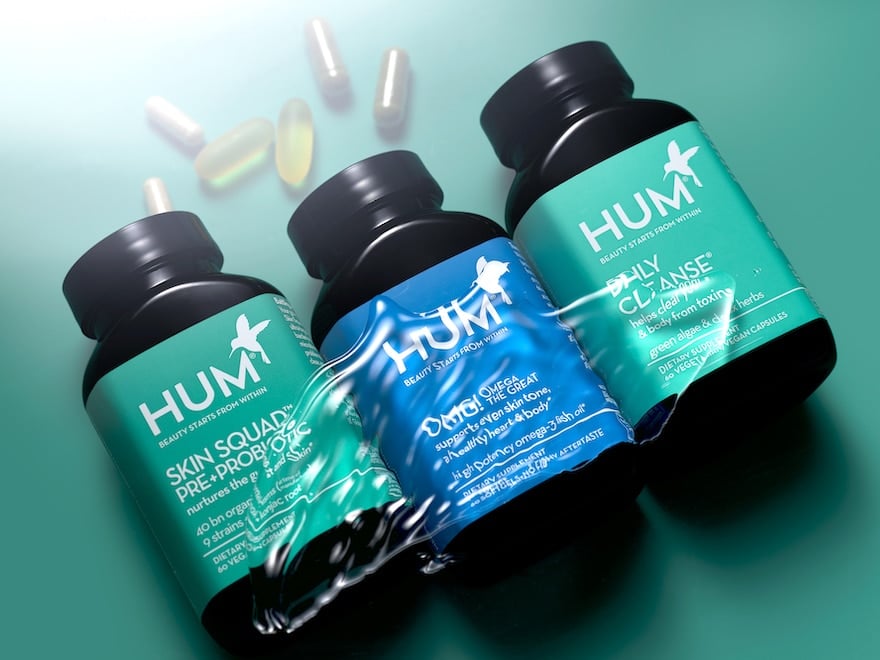
Of course, there are short-term fixes to help your skin clear up ASAP, but there are also longer-term solutions that will ensure this problem doesn’t rear its ugly head again (and again).
Hands Off
For starters, be gentle with your skin. Translation: Hands off those pimples! Picking or squeezing blemishes can cause further trauma to the skin and lead to infection or scarring.
Treat Breakouts Gently
And in general, acne treatments for adults should be different from acne treatments for teens. “Over-the-counter treatments for teenagers tend to be harsh for adult skin, which is prone to dehydration and sensitivity,” explains Dr. Green.
For topical treatments, Morariu says to look for ingredients such as salicylic acid (which naturally occurs in willow bark), antibacterial herbs like olive leaf, exfoliating enzymes like papaya and pineapple, fruit acids, lactic acid sourced from beets, and more. “All of these can help unclog your pores, regulate sebum production, and decrease bacterial overgrowth.” Facials can also help get your skin in tip-top shape, whether you opt for a medical-grade HydraFacial or a spa-based one that includes light therapy.
Topical retinoids can help with mild hormonal acne, but cystic acne might need to be treated with oral medications such as birth control pills or anti-androgen drugs. That said, seeing a dermatologist is always a good idea. If you’re pregnant, it’s necessary, since certain treatments should be avoided.
Try an Inside-Out Approach
Morariu recommends an “inside and outside approach to change the milieu that created the acne to begin with.” The “inside” part begins with your internal biochemistry—changing your stress levels and diet, as mentioned above. But you can also support your skin’s health by incorporating supplements into your routine. To keep skin clear, add these to your arsenal:
Skin Squad: These vegan capsules contain nine types of probiotics, as well as prebiotic konjac roots, to help balance your gut microbiome. A dermatologist-supervised study showed that women with non-cystic acne who took these for 60 days experienced an 88 percent decrease in breakouts.
Daily Cleanse: Two types of green algae (chlorella and spirulina) help to bind impurities and flush them out of your body, while a slew of detoxifying herbs, antioxidants, and minerals also work to get rid of toxins and make skin glow.
OMG! Omega the Great: Omega-3 fish oil improves your skin’s hydration and decreases redness (plus helps your heart in the process), while vitamin E will make skin luminous. You’ll definitely be saying “OMG!” after a few weeks.
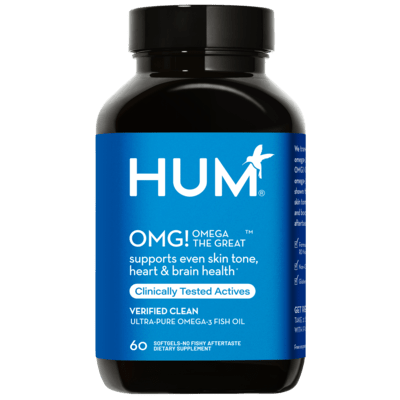
The Takeaway
You don’t have to live with adult acne. A few changes to your diet, lifestyle, or beauty regimen could clear up your skin and turn your breakouts into a distant memory.

